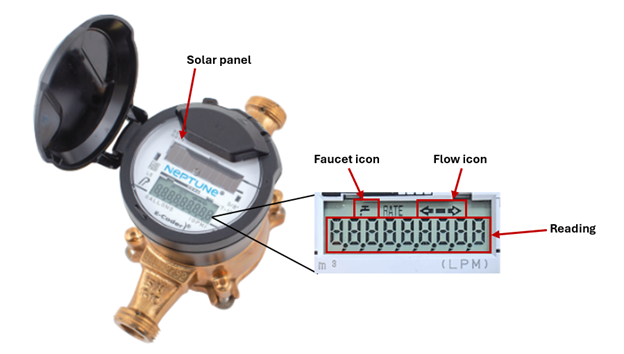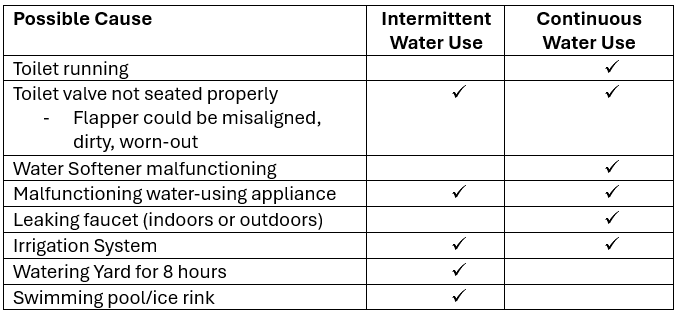Water Meters
Water Meters
Learn about Town of East Gwillimbury's (EG) water meters, by reading the frequently asked questions below:
Finance
When am I billed for water consumption in my home? |
| Your water meter is read approximately every 30 days. The bill is based on how much water was used since the last reading.
If you have questions about your water bill, or water rates visit Understanding your Water and Sewer Bills - The Town of East Gwillimbury |
How does the water meter work? |
The meter installed in your home is a positive displacement water meter to ensure accurate reading of water usage. The meter works by filling a small chamber on the inside of the meter every time water passes through, and the cycle of filling and emptying is translated into a usage reading.
|
What is the accuracy of my water meter? |
| The installed water meters are highly accurate and are tested to ensure compliance with the American Water Works Associations (AWWA) Standard C700.
AWWA C700 specifies a residential meter must measure within ±1.5% accuracy during normal flows, and no worse that ±3% at low flows. Over time, due to mechanical wear and buildup, older meters can slow down and lead to under registration of water usage. |
I just got a new meter – why did my bill go up? |
| Water meters slow down over time which can under report usage. Therefore, a new meter may result in a higher bill simply because it is more accurate. |
Why did my bill increase this month? |
There are several reasons why your water bill may be higher than usual. Some of the most common factors are:
Occasionally, billing cycles may be slightly longer than 30 days due to holidays and scheduling. A longer billing cycle can result in a higher bill simply by having more days included. |
What should I do if I think my meter is wrong? |
| First, consider your water usage and use the tips in our “Get Familiar with your Water Meter” section to discover potential unknown water usage
If you would like to get more details on your water consumption, The Town can provide you with hourly readings of your water meter to show when water is flowing. This service can be requested through customer service The Town’s Water Works By-law #2015-104 outlines the additional steps that may be taken if a resident would like to dispute the meter’s accuracy. This involves testing of the water meter and resolution based on the results. Please note there is a fee for this. |
I received a High Water Consumption notice |
| If your monthly meter reading shows water usage significantly higher than your typical consumption, the Town may leave a high consumption notice at your door. This is a courtesy notification and is intended to help you determine potential causes of higher water use – was it from a known source such a swimming pool being filled, or could there be a leak somewhere?
The notice will provide information such as:
See the section below for how more details on how to investigate |
Get familiar with your home water meters!
How do I read my water meter? |
|
Follow these steps: 1. Locate your water meter and lift the lid on top 2. Shine a bright light at the solar panel (near the top) to activate the display
3. Read the usage number. This number shows the total volume of water passed through the meter since installation. On a newer meter the decimal place is in between the 5th and 6th digit, and the reading is in cubic meters (m3)
4. Find the flow icon. Above the usage reading there is an arrow displayed if water is flowing. When the right-side arrow is visible there is water currently flowing in the home. If the arrow is flashing, water is running very slowly
5. Find the faucet icon. There is a space for a small faucet (“tap”) icon above the reading on the left-hand side
NOTE: a flashing icon may take up to 24 hours to clear after intermittent usage has stopped
NOTE: If you make a repair, or turn off a water-using appliance, please do not use water and wait for at least 15 minutes. After 15 minutes, the indicator should change to flashing and disappear after 24 hours
|
Checking for Leaks
What could be causing a leak? |
|
There are many things that could cause a water leak on your property. The leak indicator on your water meter can help determine potential causes. See above on how to read your meter. Remember: intermittent = water usually flowing, continuous = water always flowing
Keep your ears open for the sound of running water, and look for any wet spots on the floor, walls, or in the yard! |
How can I check for leaks at home? |
|
Perform a leak test at home using the steps below:
Examples: dishwashes, ice makers, water softeners, laundry machine, irrigation system
Check your toilet with a Dye Test
|
How much can a leak cost? |
|
For water rates, leak costs, and water conservation strategies please see: |
Who is responsible for fixing leaks? |
| Any leaks after the curb stop are the responsibility of the homeowner. |
Contact Us
Our Customer Service Team is here to help!



